Sundress is an indispensable element of women's wardrobe. It can be beach, home, city, office, and even evening. To create any of these options on your own will help patterns of sundresses.
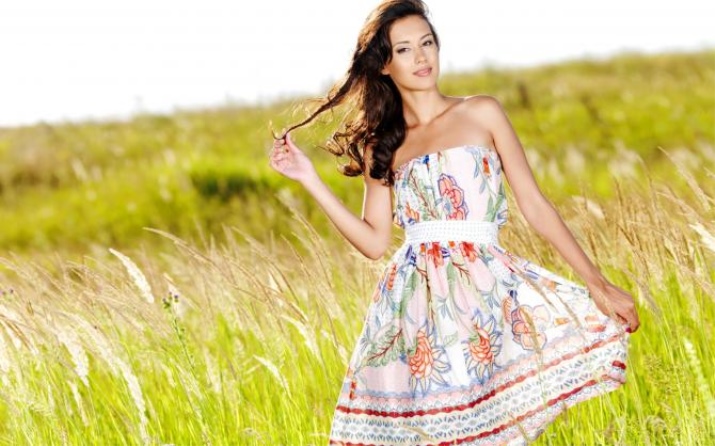
Summer beach pareo-sundress quickly and easily do it yourself
The hot season requires light clothing, and a sundress is very welcome here. Natural, flowing, flying fabrics will help you to feel comfortable and be irresistible both in your own garden and on the evening boardwalk along the streets of the resort town. Of course, there is nothing more convenient than a sundress for hiking on the beach.
It is easy to make a beach model at home in an hour, using a minimal sewing kit and a primitive pattern.
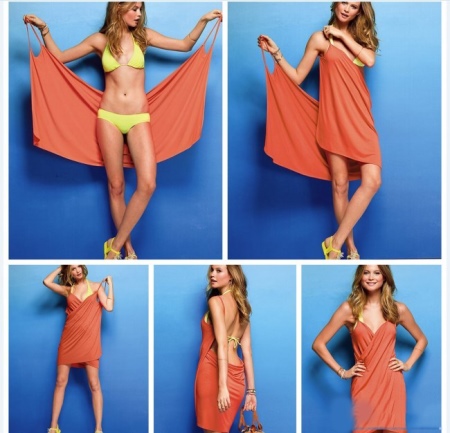
For the "sundress-vest" is required to make only one measurement - the circumference of the hips. The resulting figure must be multiplied by two, this will be the width of the sundress. The length is determined arbitrarily, the main thing is that it covers the lower part of the swimsuit. The best option is to mid-thigh.
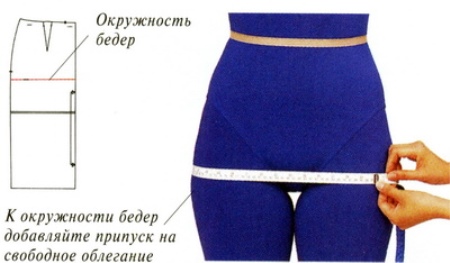
The length and width should be noted on the fabric, carefully cut the rectangle. If the material is synthetic, it is enough to cut it with hot scissors without edge treatment. In the upper right and upper left corner, make two armholes with scissors, and the product is ready.
If the fabric is natural, you need to add one and a half centimeters per stitch to each edge on the pattern, and additionally cut two strips for strapless.

Stitching the strap, the fabric rectangle is folded in half so that the wrong side is up, it is trimmed in length and width on one side, turned on the front side with a hook or pencil, then the second side is sewn in width.
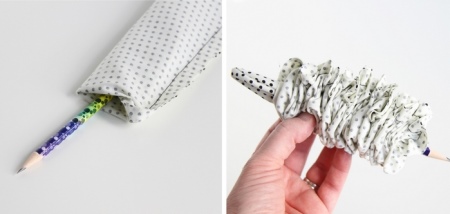
Straps are sewn to the upper corners of the product treated with an overlock on all four sides.
It is very simple to put on a sundress. One strap should be thrown on the right shoulder, skip the fabric in front under the left hand, wrap it back, forward again, and put the second strap on the left shoulder. The fabric is beautifully draped, taking on the shape of the body, and will open a nice cutout on the back.
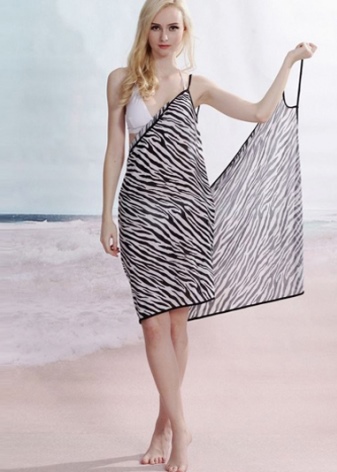
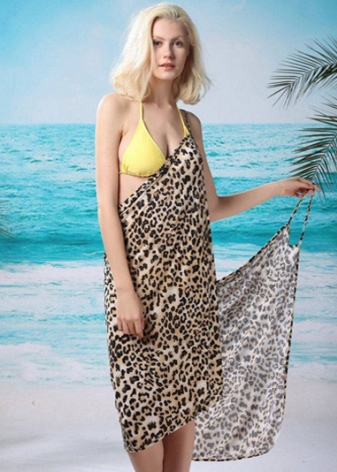
This model can be worn in another way. Wrap it around the body, in front of the chest, and tie a bow or a beautiful knot. The material should be enough so that the fabric falls off freely and completely covers the swimsuit. When walking, such a sarafan-pareo will flutter beautifully, showing a tanned body, but will not make the image too frivolous.
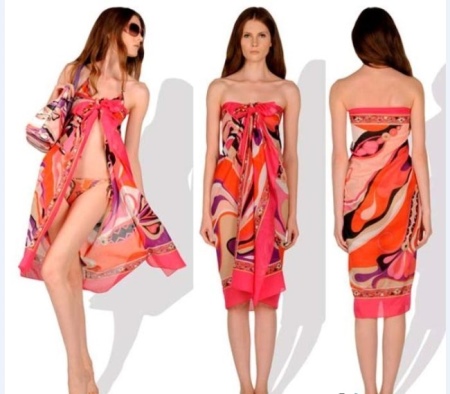
How to sew a model with a shuttlecock on the shoulders?
In the past few seasons, clothes with bare shoulders have not gone out of fashion. To get into the trend, it’s enough to complicate the pattern of your summer sundress a little, and sew a product with a beautiful frill on your shoulders.
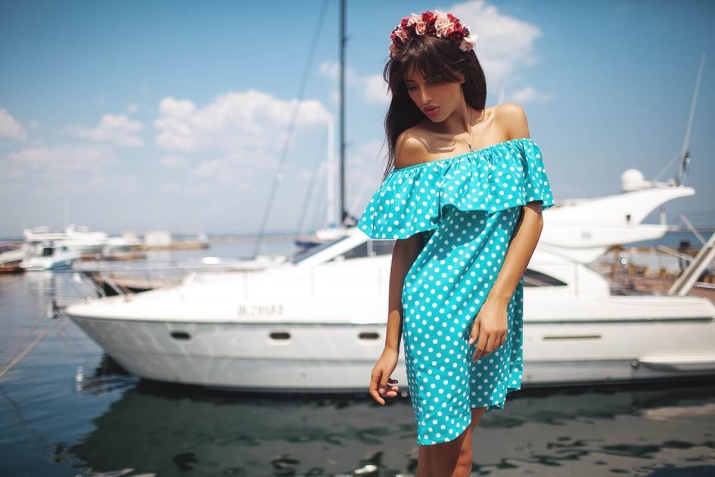
To do this, you will need:
- the cloth;
- threads for color;
- crayon;
- safety pins;
- scissors;
- tape measure;
- notebook and pen;
- elastic band from 1 to 1.5 cm wide.
The work is carried out in stages:
- The first step involves taking measurements. For a simple dress, traditionally you need to find out the half-circumference of the chest, waist and hips. If the dress is not fitted, it is enough to measure the chest and hips. If the chest is very lush, when cutting the fabric, extra centimeters for tucks are taken into account.
Measurements determine the size of the finished product, so it is important to do everything right. In order not to be mistaken, you can use the cheat sheet from the Internet;
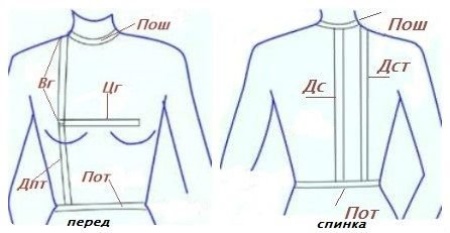
- The second stage is drawing a pattern. 4 details are needed: two on the base of the dress, two on the shuttlecock. The length and width of the dress are cut out in accordance with the measurements obtained, plus 3 centimeters per allowance on each side. The size of the shuttlecock depends on how draped it should be, plus 2 centimeters at the seams. Separately, a belt is made of the same fabric;
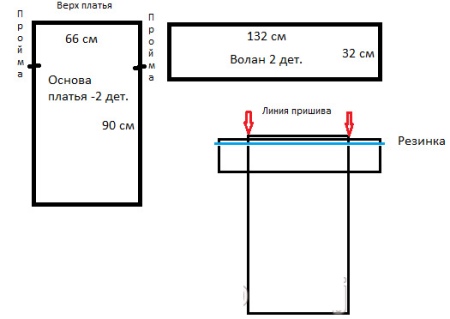
- The third stage is sweeping. It is necessary to reduce the excess or make a new pattern, if there is a risk that the thing will be too small. In addition, it is easier to work on a typewriter when the parts are already fastened to each other with a preliminary seam. It is better not to sew the shuttlecock to the base, but pin it with pins;

- At the fourth stage, a machine is used for firmware. Two base rectangles should be sewn together, not reaching 25 cm to the top edge - these will be armholes for the hands. On them you need to lay the finishing line.
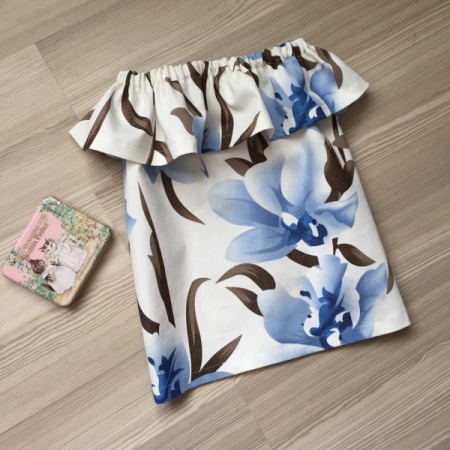
Parts of the shuttlecock are sewn along the side seams, then you need to connect the middle of the base dress and the middle of the shuttlecock so that the same amount of fabric protrudes along the edges. You should get a T-shaped dress with a margin for fabric allowance on top. Then chop the two parts with pins and sew the shuttlecock to the base from the armhole to the armhole on both sides.
Now it’s time to hem the top of the sundress with a seam in a hem with a closed cut, leaving a small area through which the elastic will be pulled. The width of the seam should be slightly larger than the width of the elastic, the length of the elastic should be equal to or slightly less than the circumference of the shoulders.
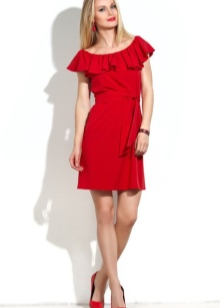
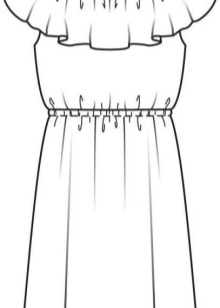
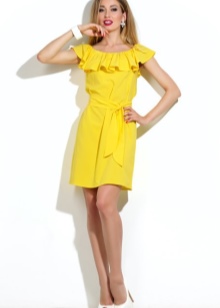
To get the gum in, it will be convenient to fasten a pin to one end of it, stick it into the unstitched end and, picking up the fabric, stretch it all around to the next hole in the seam. The ends of the gum can be swept away so that it is more convenient to machine, remove the pin.
When the top of the dress is ready, it remains to hem the hem and the lower edge of the shuttlecock with a seam in the hem and process them with an overlock.The belt is last sewn, and the sundress with a shuttlecock on the shoulders is ready.
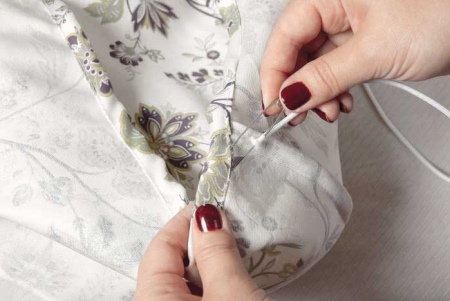
This model suits girls with absolutely any figure. It can be modified with a belt and accessories, and make it your favorite outfit for a walk or a romantic date.
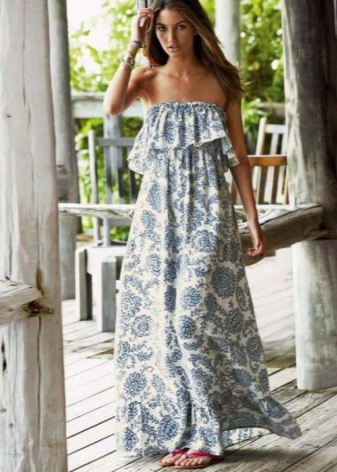
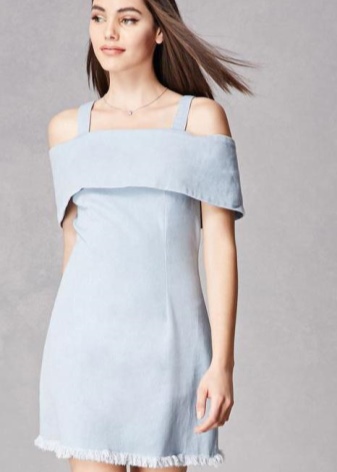
Sundress with frills can also be sewn from knitted fabric. It turns out very interesting and unusual models that are perfect for both a walk and an evening out. The following video will explain how to do this:
Flax boho sundress pattern
Boho - the name of the style, which implies an abundance of cotton fabrics, floral motifs, bright colors, lace, long skirts on the floor, and other attributes of bohemia and "children of flowers." All this is perfectly suited for summer sundresses.
The choice of fabric depends on the style. The model in the classical style will be made of velvet or knitwear, boho-glamor embodied in lace and chiffon fabrics, hippie-chic tends to burlap and suede, boho-eco for naturalness. But the most universal option for warm weather and everyday wear is a flax sundress.
Linen clothing is 100% natural, has unique hygienic properties, breathes, does not cause sweating, and is pleasant to the skin. It is easily washed, dries quickly, does not fade, does not fade, and is practical to wear. In addition, linen items look unusual, stylish, and, despite their brevity, expensive.
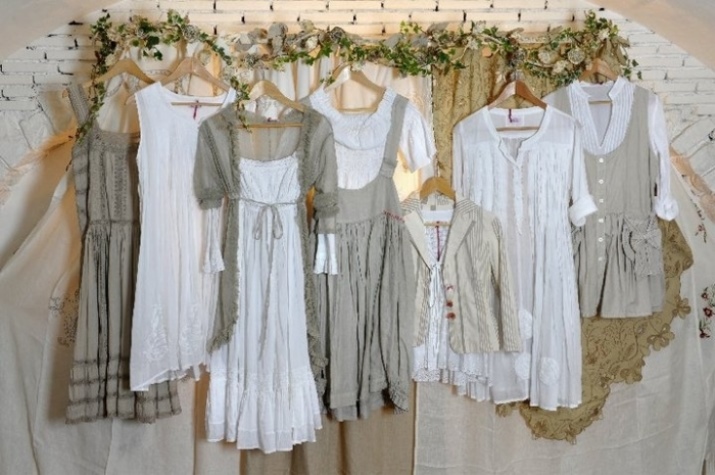
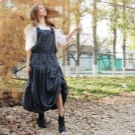
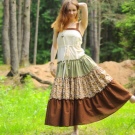

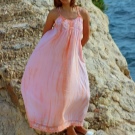
The simplest pattern of linen dress in boho style consists of a minimum number of parts and does not require complex measurements. This is the so-called sarafan apron on wide straps.
The pattern is assembled from three or four parts, depending on whether the back is planned for the sundress, or the straps will be sewn to the waistband of the skirt. A classic sarafan apron consists of breasts, crossed straps and a skirt.
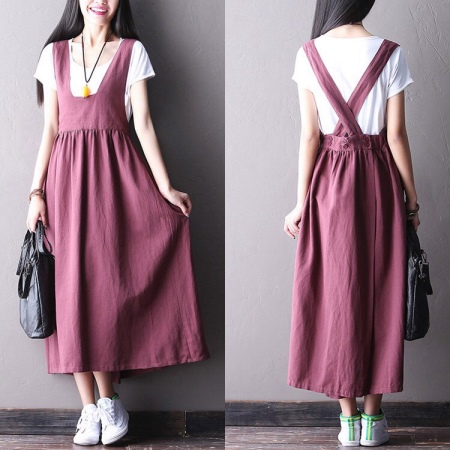
To draw a pattern, it is necessary to measure the width of the chest (chest part of the sundress) and the height of the chest part. The length of the straps consists of the height of the back and half the height of the front, plus 2-3 centimeters per seam. The width of the straps is chosen arbitrarily.
The pattern is presented below.
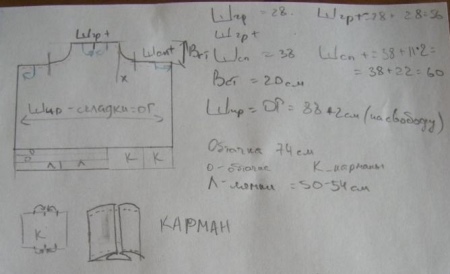
Sewing starts with the breast being separately shortened and the straps sewn. The straps are sewn to the breast, then folds are collected on the canvas skirt. A belt should be formed on the back for this; a strip ten centimeters wide is cut out and stitched.
The hem of the skirt is hemmed with a seam and processed with an overlock. Last of all, you need to sweep the upper and lower parts of the sundress and flash everything on a typewriter.
The color of the summer sundress can be any: white, blue, green, blue, cherry, brown. Fine floral prints, velveteen and ethnic motifs are suitable.
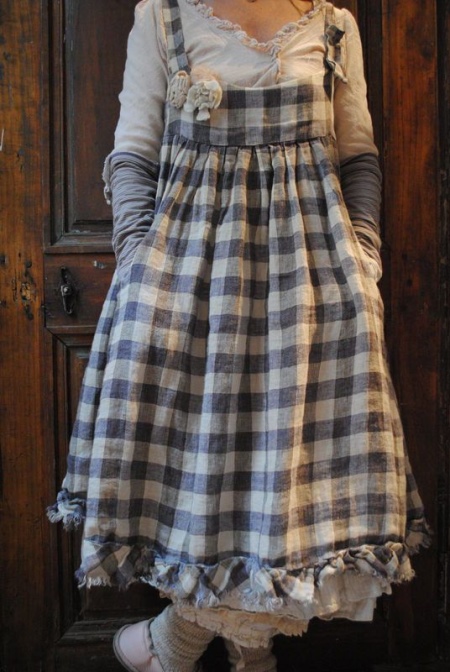
It is important to wear a sarafan apron over t-shirts, shirts, blouses. As an outerwear, it will be supplemented with a large knit cardigan, a thin parka or a faux suede jacket.
For pregnant
Summer straps
This model is specifically designed for changes that have occurred with the figure. She sits quite freely, without tightening her stomach and without constraining, and emphasizes the beauty of a woman during pregnancy.

To simulate a pattern is very simple. A classic sundress with wide straps consists of only two fragments: the base and the straps themselves.
For the basics, you need to measure two parameters: the length from the armpit to the knees, calves or ankles as desired, and a width equal to the waist circumference at the point where the stomach protrudes most.
If there are still a few months remaining until the end of pregnancy, the width can be arbitrarily increased by 10-20 centimeters so that the sundress turns out “to grow”.
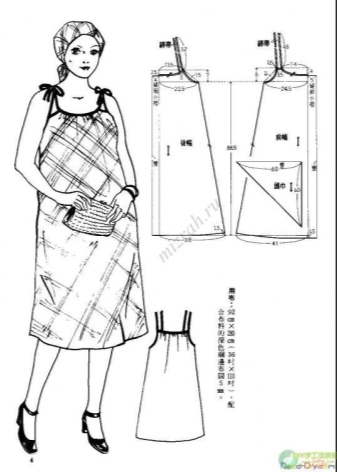

Warm
For a cool time, stock up on a model with large pockets of wool blend fabric. It will be perfectly combined with turtlenecks and blouses. A sundress will look different if you sew it from jeans, velvet or any other dense fabric.

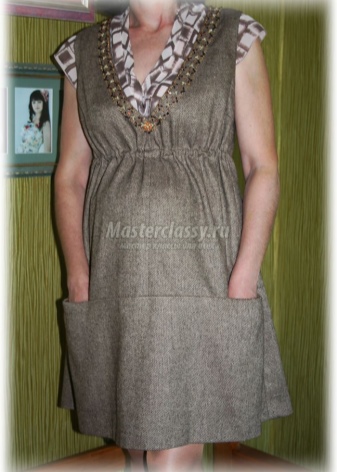
In addition to the main fabric 120 cm long, you will also need a lining for the pocket and glue, as well as an elastic band, drawstring tape and standard sewing equipment.
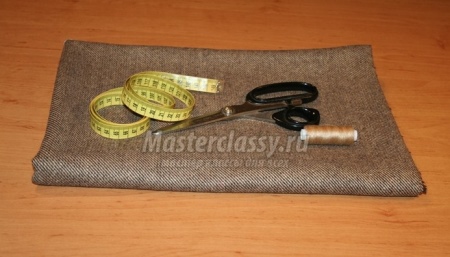
Below the details of the pattern, enlarge to the desired size and print.
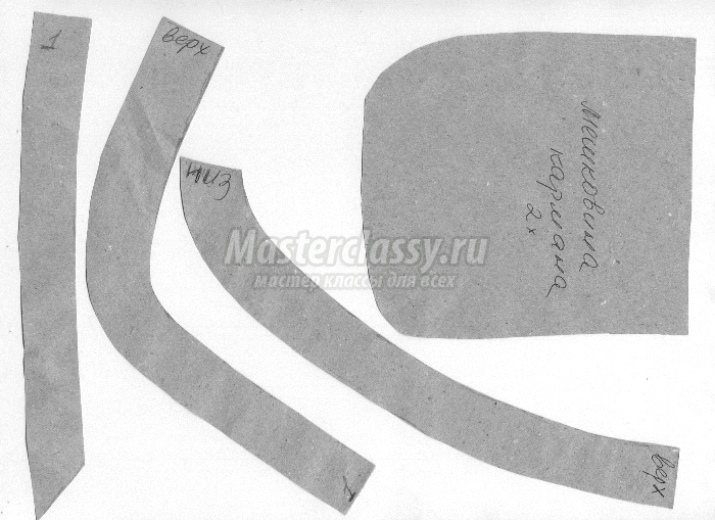
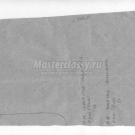
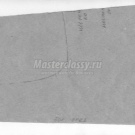
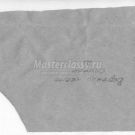
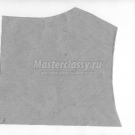
Cut
Fold the fabric in half and distribute the patterns on it. The bottom is cut out separately. After securing the parts with pins, circle the contours, add allowances of 1.5 cm on the sides and 2 cm from the bottom, then cut.
Two pockets are cut out of the lining fabric with allowances, which must be pinned to the bottom of the front with pins. For density, the kiper tape is glued from the wrong side.
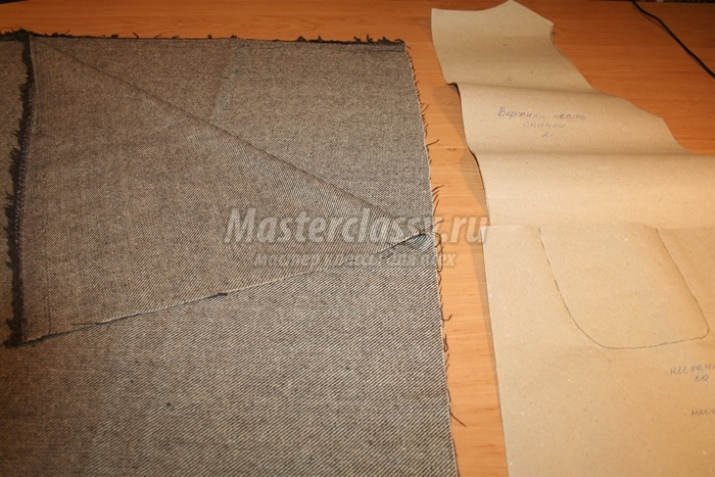
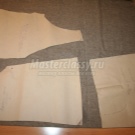
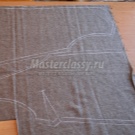
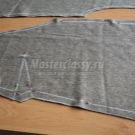
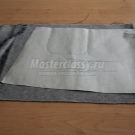
Assembly
We grind the middle section of the upper parts of the front, process the allowances and inflate the seam (the last actions apply to each seam). Stitch the lower part, combining the pockets. Then we grind the tucks. Next, we connect the details of the back and shoulder sections.
From the remnants of the fabric we cut out the stitches and sew them, having previously strengthened them with adhesive material.
After trying on a sundress, mark the line for the drawstring (approximately 10 cm from the line of the chest), grind the tape, grind the side sections and thread the elastic into the drawstring. It remains to process the lower edge and decorate the new thing with beads or any decor to your liking.
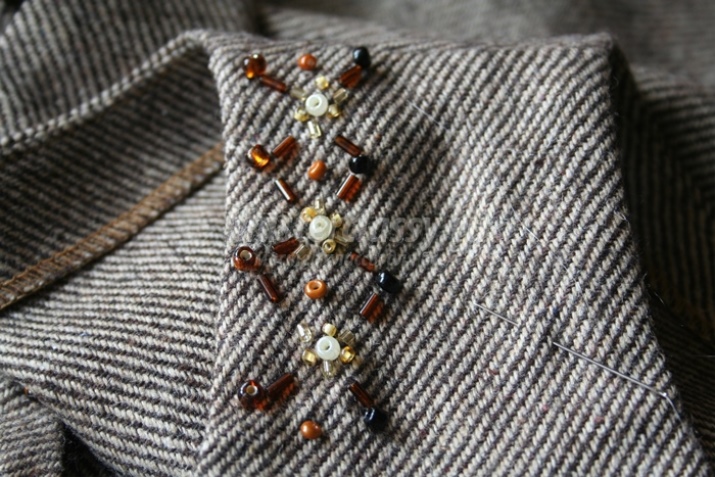
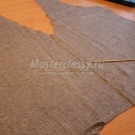


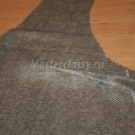
For full with smell
It is a mistake to think that dresses are the prerogative of extremely slim young ladies. There are a considerable number of sundresses models that can emphasize the appetizing forms that captivate men from the Renaissance to the present.
At home, it is important to choose the right style. On a full figure, from 52 sizes and larger, wide models look beneficial, but not shapeless hoodies, but with an emphasis on the upper body. V-neck styles are considered successful, which emphasize the lush chest and visually lengthen the neck, as well as models with a detachable waist.
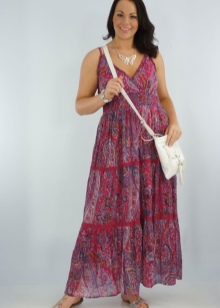
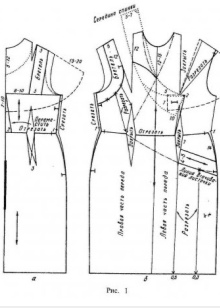
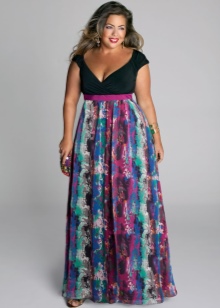
A universal option that hides flaws and focuses on the advantages of a voluminous figure is a sundress with a smell.
There are several ways to model a bodice. Here we can’t do without a dress pattern.
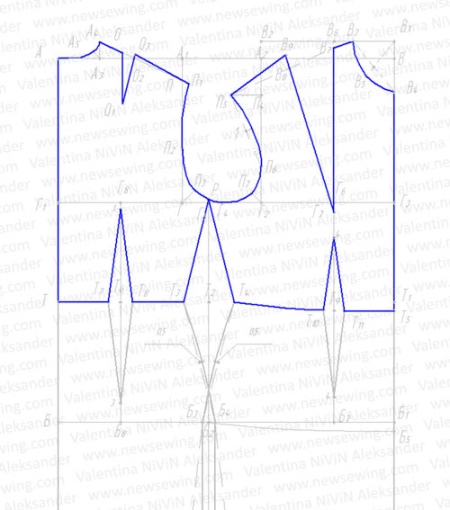
Along the waist line, cut off the top of the preferably detailed pattern. We close the chest undercut, and we will expand the waist. Make a cut to the top of the closed chest and put a point, as shown in the drawing.
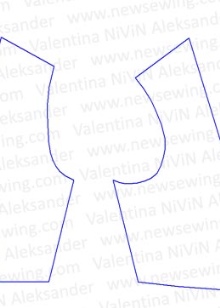
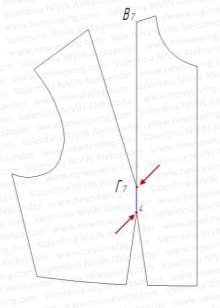
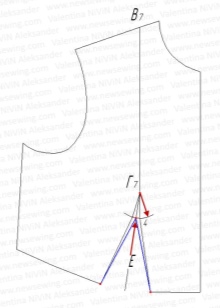
We proceed to the formation of the bodice. From the top point in the side cut, lay 4 cm down. From the received point to the right, put 1 cm (point 6) and draw a parallel line.
From point B4 (midline) on the pattern, 13-15 cm are measured (point K). You can do more. From the lower top of the shoulder tuck G7 upwards, measure 10 cm and get the second point (K1). Now we connect it with points K and 6. But since you need to make out the smell, the K1K line should go to the left shelf, at least 5 cm from the line of the middle of the front.
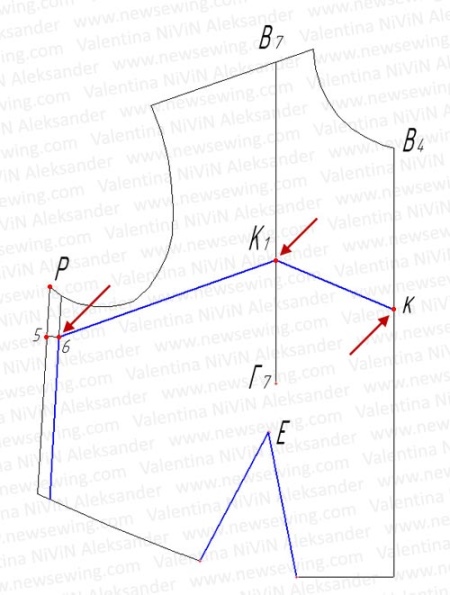
Now you need to simulate the back. From the top of the side cut we measure down 4 cm and to the left 1 cm. From the obtained point, draw a horizontal line to the line of the middle of the back, and also parallel down, as in the front pattern. The thallium tuck closes, and the slices at the top and bottom are rounded off by smooth lines.
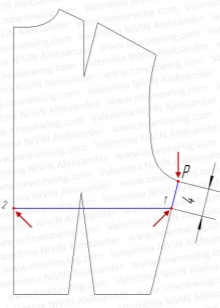

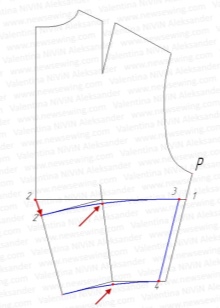
The final version of the bodice is odorless.
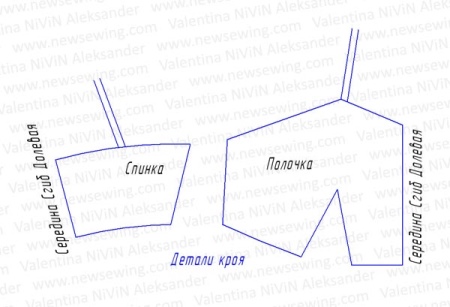
In the second version, we decrease the lateral cut by 4 cm, and increase the length of the right doormat by 5 cm. The lower tuck does not close, but is attached. Mark the beginning of the calyx by measuring on yourself from the shoulder line. Then, as shown in the pattern, connect the top point with a straight line to the odor point and a smooth line with a side cut.
As for the skirt, it can be straight, flared or half-sun.
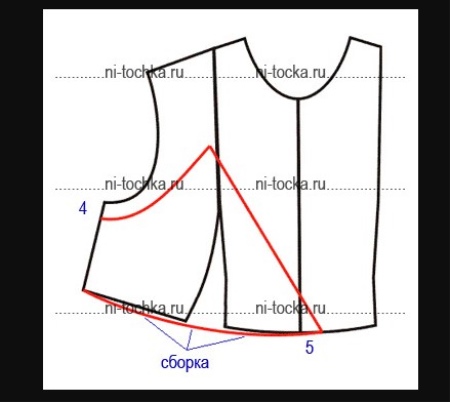
There is a third option. You can draw on paper, for example, a top with a smell. If necessary, correct and transfer to the fabric. After cutting, we combine the halves of the front and combine.
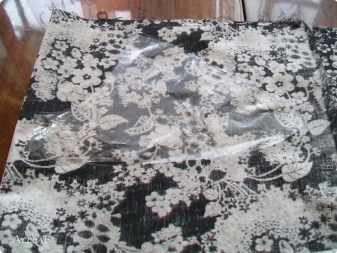
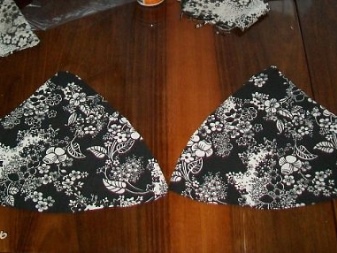
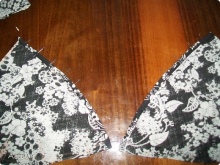
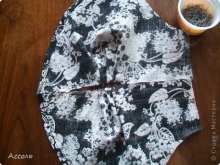
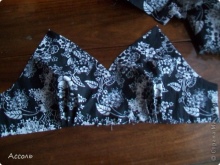
So that the model is fitted and unnecessary seams are hidden, we will cut 2 parts of the coquette 10 cm high.A “sandwich” of the coquette, bodice and second part of the coquette is sewn together. In this case, both should be facing out. We process armholes with a slanting inlay.
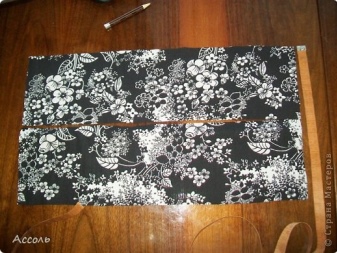
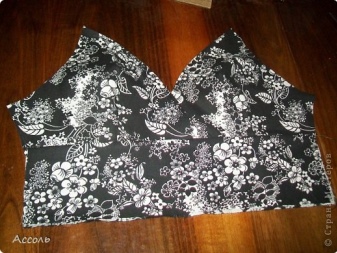
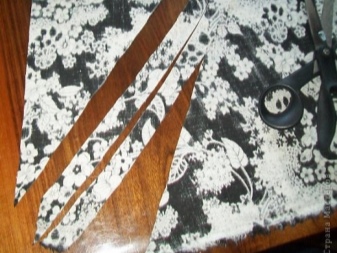
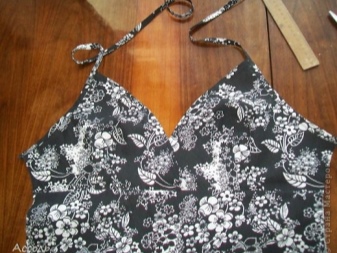
The back will be collected on an elastic band. For her, a rectangle is cut out 1.5 times wider than the size of the back and the length from the beginning of the armhole of the front to the end of the yoke.
Having made a hem and stitching the back with an elastic band, we grind it to the front. It remains to cut out a skirt and work on the bottom.
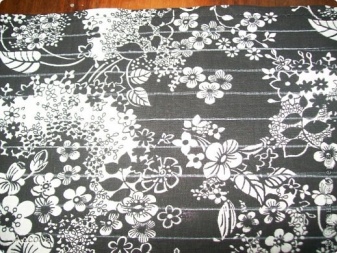
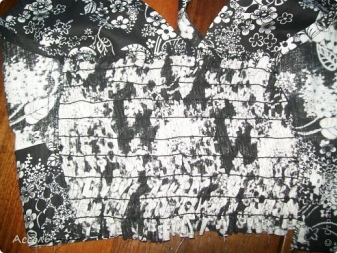
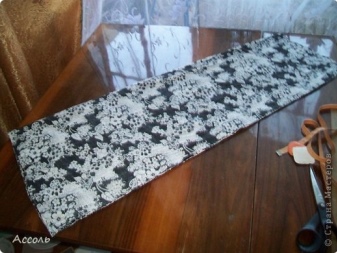
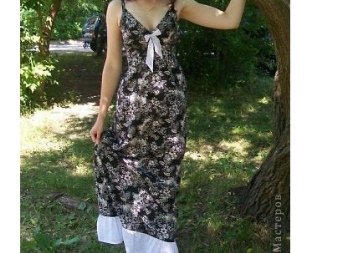
An example of modeling a sarafan from chiffon, see the next video.
Modeling a dress with an open back
A thin linen green dress with a slightly lowered waist perfectly emphasizes the tan. And it will give the image of brightness and a little extravagance.
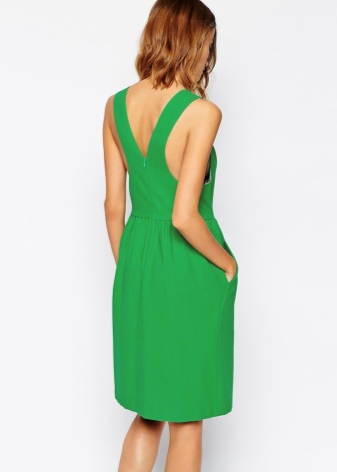
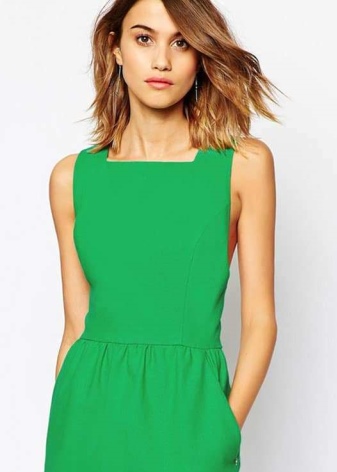
On the pattern-based front of the dress, we transfer the chest tuck into the relief as follows: we divide the armhole line in half, put the point from which we draw a smooth line through the tuck at the waist. The tuck on the shoulder closes. Then we increase the waist line by 2 cm, and deepen the armhole line.
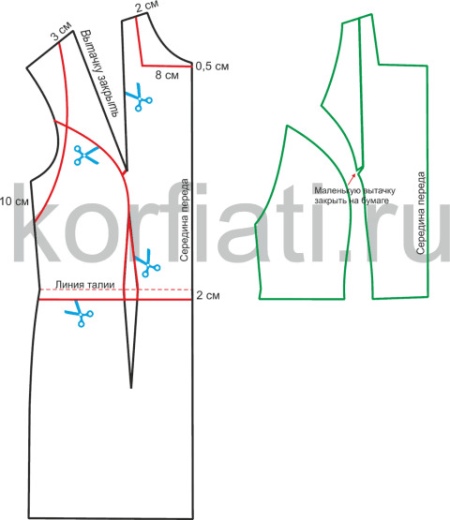
We deepen the cutout and armhole on the back, and transfer the tuck at the waist to the side cut. The waist line is also lengthening.
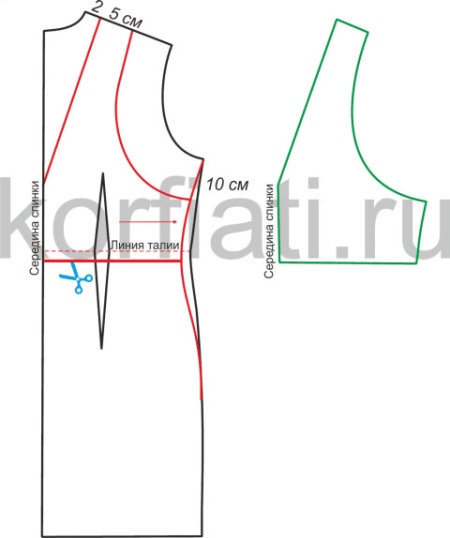
For a skirt, measure the circumference of the hips.
Draw a rectangle. Width - ¼ thigh circumference, and length - 60 cm. For a loose fit, add 3 cm.
In front of the skirt at the top we measure 10 cm to the right and 25 cm down. Cut the side and cut separately. Draw a pocket.
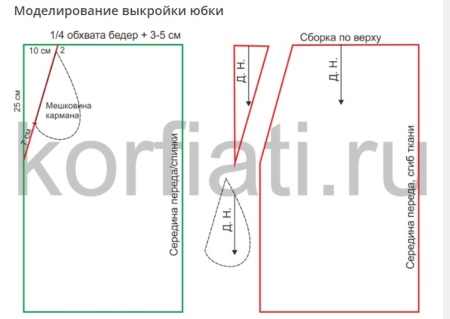
The final result is lower.
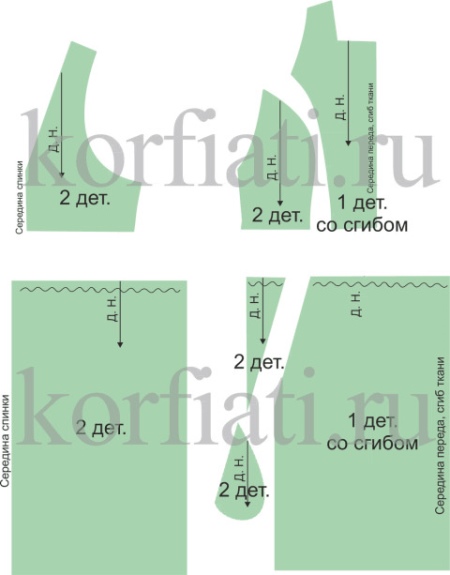
In addition to flax, crepe, satin, poplin or any other cotton cloth is suitable for this dress. The back closes with a zipper.
Also, when cutting all the details, be sure to increase the seams.
For summer, a sundress with ties that completely exposes the back is also suitable.

Elastic model
An open back is beautiful, feminine, and most importantly - it is appropriate in an everyday look in the summer heat. Another indisputable plus is that you can sew such a sarafan on your own with a very simple pattern or without it at all.
Among the models that do not require preliminary construction of the pattern, the easiest to perform is a sundress with an open back on an elastic band.
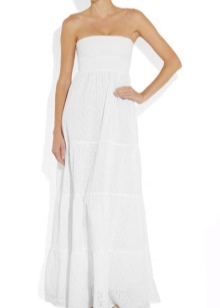
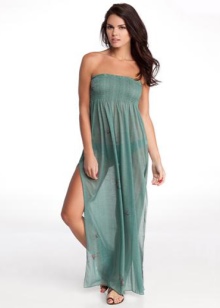
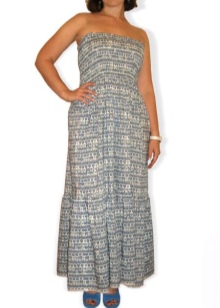
The basis of the style is the rectangle of the fabric, where the width is equal to the circumference of the hips, plus 6 centimeters for processing the edge, and the length is measured directly from the figure from the level of the armpits.
Varying this setting, it's easy to get a naughty short dress or floor outfit for an evening out at a spa party.
When the base of the sundress is ready, it is spread on a flat surface to outline the lines along which the elastic bands will be sewn. It is important to consider that ordinary linen gum is not suitable for this purpose. They will look rough, ugly wringing tissue and squeezing the chest.
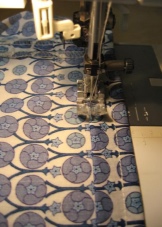
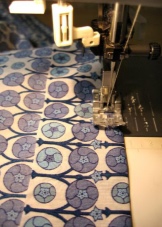
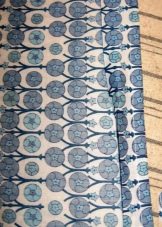
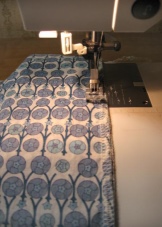
For a sarafan, it is better to use a gum thread, while the fabric needs to be sewn before the rectangle is sour along the back line or the side seam into a full sundress.
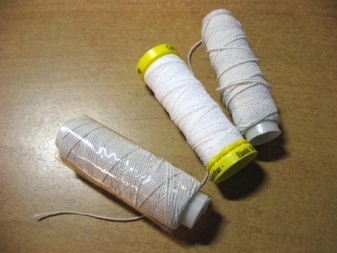
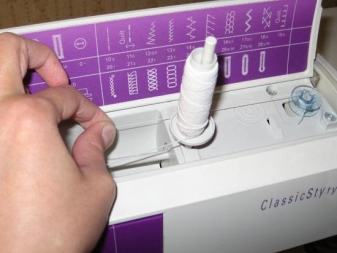
There are two ways to sew a gum thread to the fabric: stitch it with a zigzag, applying it to the wrong side of the product, or insert it into a bobbin and use it like regular threads.
The second option is faster and simpler, but in both cases it will be useful to draw a line along the line at the same distance to make the line smooth and beautiful.
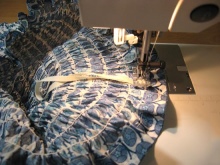
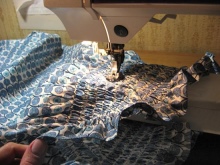
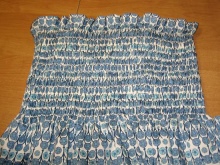
Horizontal assembly on a thread-elastic band can fill the entire upper part of the sundress or can be placed only above the chest and along the waistline. If it fills the top, then the distance between the lines should be about 1 cm. If these are two separate lines, 4-5 rows at intervals of 1 cm are enough.
A rectangle of fabric, assembled on an elastic band, is stitched from the wrong side. Then the bottom edge must be tucked on the wrong side by 1 cm, stitched with a straight line, bent another 1 cm, ironed, stitched from the front of the product. This method is called double bending.
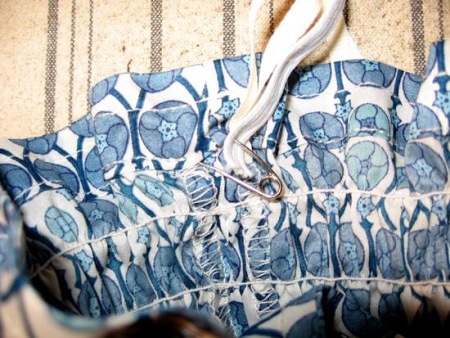
The fabric for a dress with an elastic band fits the most diverse. The one-color option in fashionable color is easier to combine with other elements of the wardrobe.Sundress with a pattern is more self-sufficient and original. From the patterns, floral motifs, ethnic and animal prints look beautiful. Geometric patterns can be corrupted by the number of elastic bands, as they are hidden by numerous folds.
Modeling a straight cotton model
Cotton sundress of a direct silhouette - the embodiment of simplicity and femininity. Such a model is very variable in combination with things of various textures and fabrics, practical, and suitable for owners of different figures. A straight elongated sundress visually makes any woman taller and slimmer, and plain fabrics and a narrow vertical strip will help to hide extra pounds.
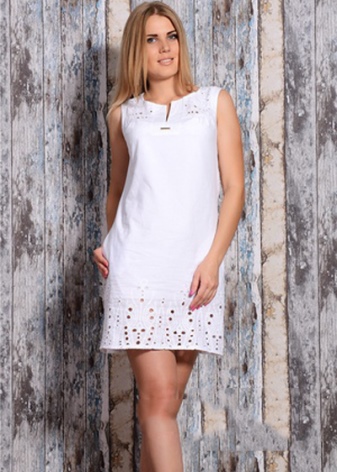

You can draw a pattern immediately on the fabric, without resorting to the complex engineering and design method that the paper base requires:
- First of all, measurements are taken. They will need only three: the girth of the chest, waist and hips. The length of the sundress is a purely individual matter.
- The easiest option with sewing straps consists of two halves. For the back, you need to note the length, apply the measurements of OG, OT and OB on it, after dividing the value by 2, connect the points with a smooth line. For a slender figure, this will be enough; for a more complete one, waist and chest tucks are needed.
- The top of the sundress can be straight, then the cutout will turn out square, V-shaped or round. Any of these options can be pre-drawn by hand.
- The width of the straps is also very variable. Thin shoulder straps will look better on thin shoulders, on sloping and full ones - moderately wide. Interesting look straps from a fabric of a different color, plain or lace. Also, lace is able to hide minor flaws in the upper part of the sundress and to extend the hem too short.
Just a few lines, and a beautiful dress for the summer is ready!
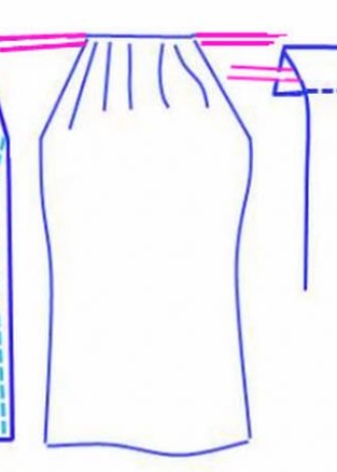
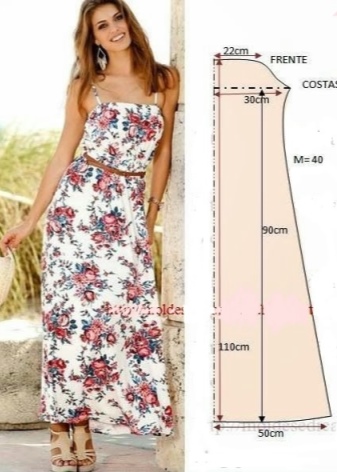
Like any product, after dressing, a straight cut sundress is tried on and checked for cutting flaws. After flashing it on a typewriter and decorating it at will.
Another affordable way to sew a straight-line sundress without drawing work is to build a pattern using a T-shirt that sits well on the figure:
- A suitable T-shirt is applied to the fabric from which it is planned to sew a sundress;
- Pin around the edges with safety pins and gently chalk around on both sides;
- Then draw the bottom to the desired length. To the resulting silhouette, you need to add 2-3 centimeters to the seams. Two whole-cut parts to cut and stitch.
- You can also sew a straight cut sundress from a modified pattern of a straight sleeveless dress. It is enough to expand the side seams of the base model so that it is easy to put on a sundress without tucks and insert a side zipper.
It is desirable that the item was not made of stretch materials. Cotton does not have the ability to stretch so much, and a sundress can turn out a size or two less.
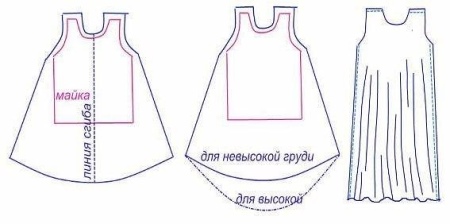
It is recommended to sew direct sundresses for the summer from light, breathable, airy fabrics of light tones or with a bright pattern.
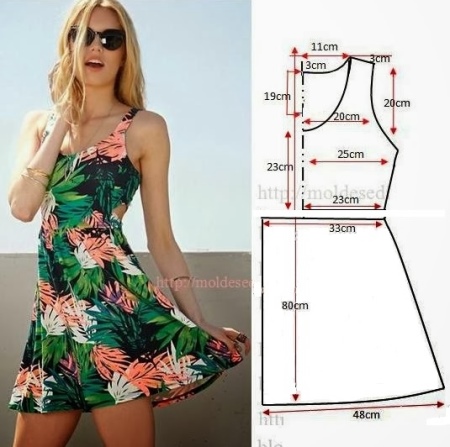
In the floor with an American armhole
An American armhole is a special cut of the top of a top, blouse or dress, without sleeves, implying a beautiful diagonal line from armpits to the neck. She fully opens her shoulders, while the neck can be demonstrated too or covered with a stand-up collar.
According to the rules of stylistics, the open top is balanced by a closed bottom - a maxi skirt.

The American armhole makes the thing more feminine, attractive and elegant. She emphasizes beautiful female shoulders, which are not only convenient, but also fashionable to demonstrate in summer.
It is not difficult to build this model, even a novice dressmaker will cope.
The following measurements will be required:
- waist circumference
- hip girth;
- product length from waist to floor;
- the length of the side from the bottom of the armhole to the waist.
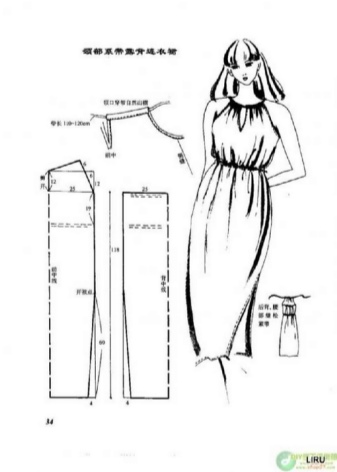
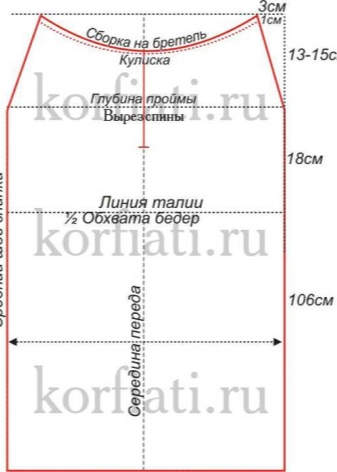
The result should be one large detail, on which it is necessary to note the height of the neck, the depth of the cut along the back, the depth of the armholes and the cut line in the middle.You can cut the front and back parts separately.
The model is stitched according to the following pattern:
- Along the center line of the front, the dress is cut to the mark of the cut, then the two halves are alternately tucked and sewed on a typewriter. The narrower the hem, the neater the neckline looks.
- The armhole and cutout on the back are processed with an overlock, tucked 1 cm and sewn. If the supply of fabric allows, you can do a double hem. The neckline is designed in the same way.
- An elastic band (it should be only at the back) is threaded into the drawstring along the back cutout, which must be pulled a little and secured with a lowercase seam. This is done so that the dress from the back sits on the figure, and does not dangle in a fold.
- For the drawstring of the neck you need to sew an inlay, which in finished form will be no wider than 1 cm, or pick up a beautiful braid. It performs the function of ties. The pigtail from strips of fabric instead of inlay will originally look.
- Put the finished tie into the drawstring of the neck. You can tie it around the neck or cross it on the back and sew to the neckline of the back.
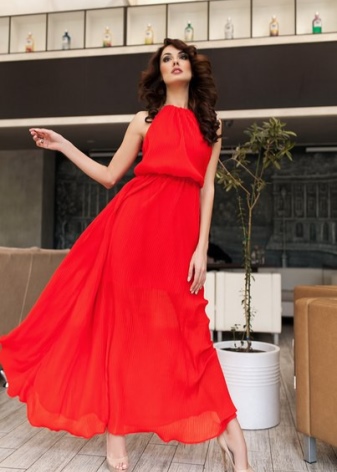
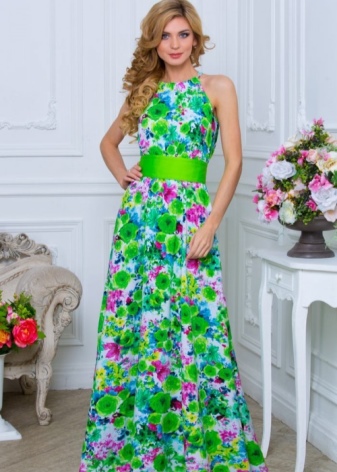
A sundress with an American armhole pretends to be elegant, therefore it is recommended to stop the choice of fabric on high-quality material in rich noble shades. The one-color model will be decorated with a belt, handmade jewelry, stripes made of beads, beads or artificial stones in ethnic style.
The maxi length makes such a thing convenient to combine with flat shoes, heels and a wedge. A simple model without decor will withstand the current combination with white sneakers or light sneakers.
Sundress trapeze
A sundress of laconic cut in the form of a trapezoid is a successful basic thing both in a summer wardrobe and in the cold season. A wide hem hides the tummy, wide hips, imperfect waist, and emphasizes slender legs. A simple top is equally suitable for owners of a neat chest and a lush bust, focuses on beautiful shoulders and arms.
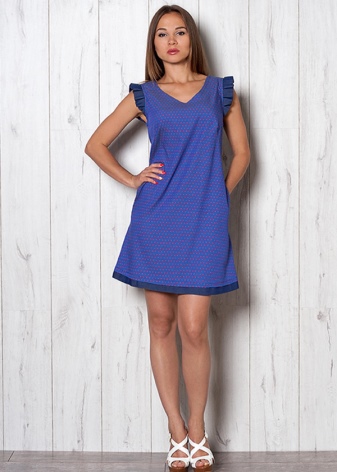
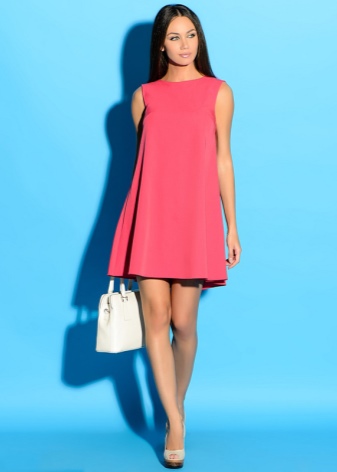
A sundress-trapeze can be with or without sleeves, with patch and hidden pockets, with a various neck shape, with embroidery, lace, flounces on the hem and other decor. Sewing any model is so easy that even someone who has never attended cutting and sewing courses and has cut nothing but a cotton apron in a technology lesson at school will cope.
The choice of fabric should be given special attention. The material should be sufficiently dense, drape well and keep in shape, not crumble in places of cuts.
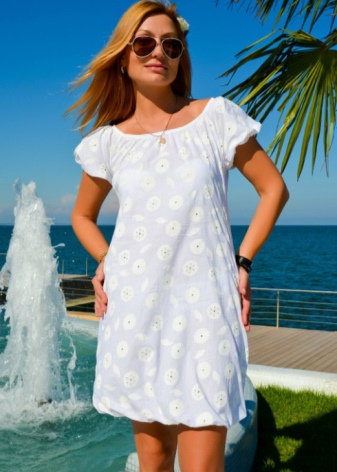
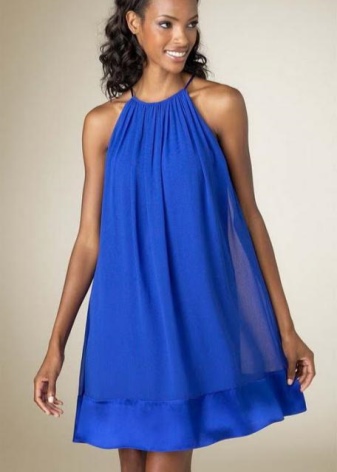
Color is suitable for absolutely any, but it is better to give preference to plain fabrics. The style is interesting in itself, and does not require additional measures to attract attention, so the fabric with a pattern can look clumsy.
You can cut a sundress immediately on the fabric, taking, for example, a dense knitwear with a stretch effect:
- With a width of 1.5 meters, only 1 meter of length will be needed, since the style assumes a short length.
- First you need to fold the fabric twice in half with the wrong side up (a pattern will be cut out on it) to make a rectangle with sides of 100 and 37.5 centimeters. Then, using chalk and a ruler, the construction of the pattern begins.
- The first thing that looms is the neck. Depth and shape can be any; the classic version is a narrow round neckline with a depth of 4 cm and a width of about 8 cm.
- Further from the upper point of the neck down, the height of the armhole is laid down, equal to half the girth of the armpit. A line equal to one fourth volume of the chest is measured through the lower point of the resulting segment, from the right edge.
- If the model is planned without sleeves, 5-10 centimeters for the shoulder seam are measured from the height of the neck to the left. The extreme point of the segment is connected by a smooth line with the extreme point of the exhaust gas - these will be the armholes.
- Then the product length is delayed. It can be made as large as the supply of fabric allows. The average length is approximately 80-90 cm. The corners are smoothly rounded, forming a hem line with a margin for hem.
- The last step in constructing the pattern is to draw one diagonal line from the extreme point of the hem to the lower edge of the armhole under the arm. The drawing is ready and can be cut out. It turns out two parts, one of which is the front part, and the second back. The neck of the front can be made a little deeper.
- Further actions are predictable and simple: sweep away two parts, try on a thing, adjust if necessary and proceed to stitching on a typewriter. All internal seams are processed by an overlock. The hem is made as narrow as possible, so the product looks neater.
About how to sew a sundress-trapeze in just an hour, in the next video.
A sundress-trapeze can be worn as an independent element of the wardrobe, and can be embedded in sets over blouses, shirts, items with a long sleeve and a high neck.
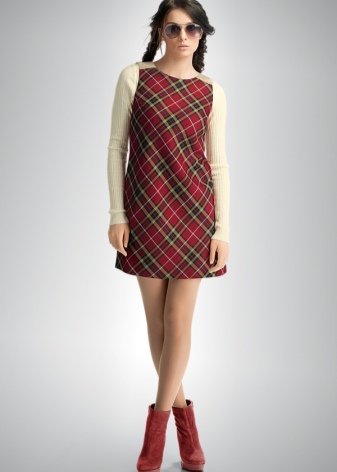
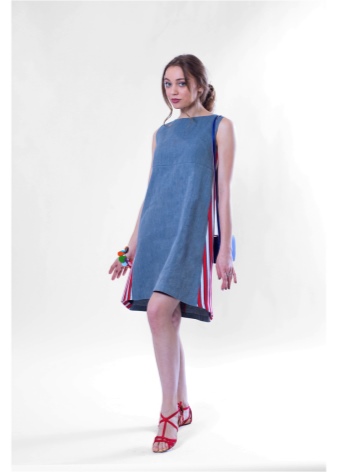
Modeling a warm business sundress
A business wardrobe should not be boring. A warm woolen dress is able to dilute classic trousers and pencil skirts, adding a twist to the image of an office lady, acceptable even with a strict dress code.
The best fabrics for the autumn-winter wardrobe are wool, half-wool, tight knitwear, viscose. They retain heat well, drape beautifully and take shape. In the monophonic version of dark blue, brown, black, gray and the color anthracite is indispensable in a business style. With them you can make multilayer sets in which it will not be cold on the way to work and not hot in the office when the heating is on.
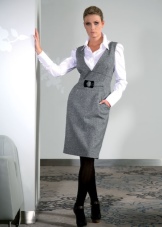
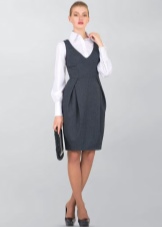
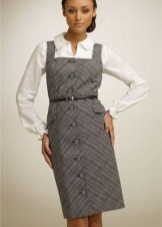
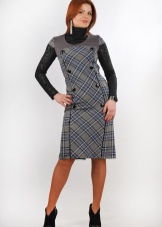
Sewing a sundress in a business style is also not difficult, although it will require more time, diligence and the correct construction of a pattern. The base pattern by individual standards is best suited.
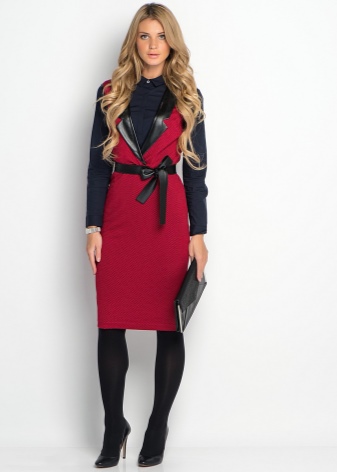

In the drawing of the front of the dress, close the shoulder tuck and open 2 grooves in the armhole and along the side cut. The latter should be directed to point A, which was obtained by increasing by 2 cm chest tuck.
We draw a new line of armholes and remove the tuck at the waist.
We reshoot the resulting pattern and cut along the waistline.
We simulate the collar shown below and re-shoot separately. We cut off the yoke.
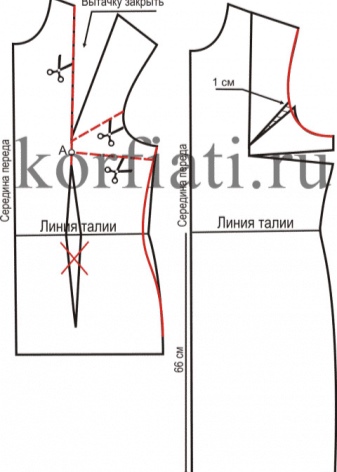

We pass to the back. We remove the tuck at the waist, increase the armhole by 1 cm and deepen the collar, and glue the front yoke to the back of the shoulder.
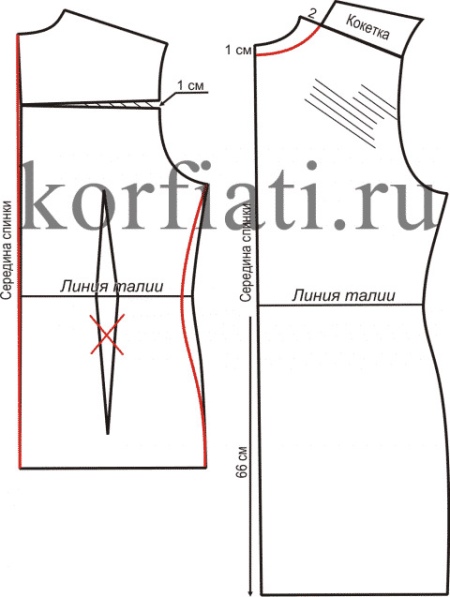
The result is such details.
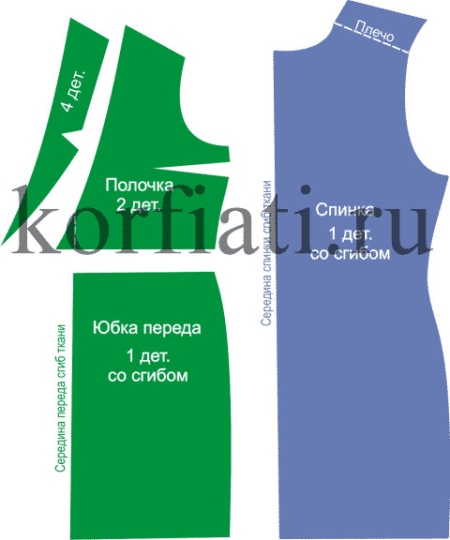
When applying the pattern to the fabric, you should also add allowances to the seams.
A collar (in the amount of 4 parts), a belt, slanting inlines for a throat and armhole cut out from the skin. For a belt, 10 cm wide will be enough. And the length is equal to the circumference of the waist, to which 90 cm is added.
We hope that our selected master classes and modeling examples of simple summer and winter sundresses will help you sew the perfect model that will please you more than one season.
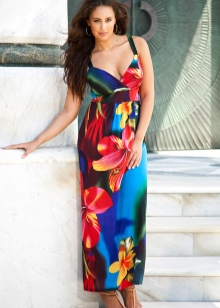
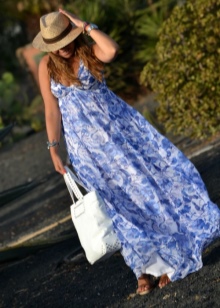
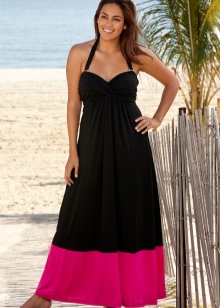
You can see workshops on tailoring sundresses in the following videos.







